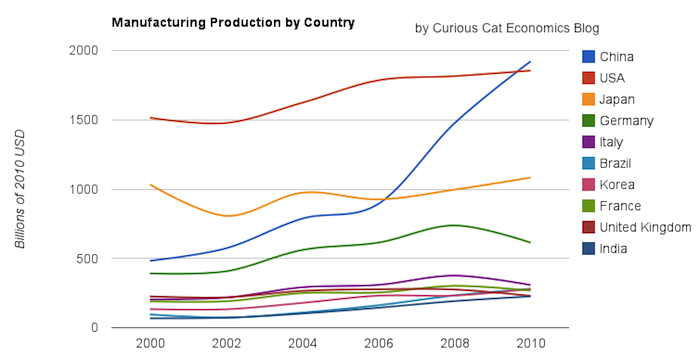
Chart of manufacturing production by the top 10 manufacturing countries (2000 to 2010). The chart was created by the Curious Cat Economics Blog. You may use the chart with attribution. All data is shown in 2010 USD (United States Dollar).
Over the years I have been posting data on the manufacturing output of leading countries. In 2010 China finally overtook the USA to becoming the leading manufacturer (long after you would have thought listening to many news sources and political leaders). In a previous post on the Curious Cat Economics Blog I looked at the output of the top 10 manufacturing countries with a focus on 1980 to 2010.
In 1995 the USA was actually very close to losing the lead to Japan (though you wouldn’t think it looking at the recent data). I believe China will be different, I believe China is going to build on their lead. There has been some talk for several years of manufacturing moving out of China seeking lower cost countries. The data doesn’t support any decline in Chinese manufacturing (or significant moves away from China toward other South-East Asian countries). Indonesia has grown quickly (and is the largest SE Asian manufacturing country), but their total manufacturing output is less than China grew by per year for the last 5 years.
The four largest countries are pretty solidly in their positions now: the order will likely be China, USA, Japan, Germany for 10 years (or longer): though I could always be surprised. In the last decade China relentlessly moved past the other 3, to move from 4th to 1st. Other than that though, those 3 only strengthened their position against their nearest competitors. Brazil, Korea or India would need to increase production quite rapidly to catch Germany sooner. After the first 4 though the situation is very fluid.
China growth will likely slow. The USA may actually do well in the next 10 years, but I doubt it will do well enough to keep up with China. The group of the 10 countries following the top 4 will continue to be interesting to watch (see a chart of the last 10 years output by these countries).
From 2000 to 2010 China grew manufacturing output by 298%. India was next at 232% and Brazil followed with 193%. The UK performed the worst, up just 2%, while Japan was up 5%. The USA was next worst up just 22% for the decade. Still even that poor performance was an increase (these figures are all in 2010 USD – the increase isn’t just “inflation”).
For decades there has been all sorts of talk about how the USA doesn’t manufacture anything anymore. This is just false. It is true that manufacturing jobs have been disappearing but this is a global phenomenon (even in countries growing manufacturing very quickly). It is also true the rest of the USA economy is growing faster than manufacturing output over the last few decades and so the percentage of manufacturing compared to the overall economy has shrunk (but this is due to higher growth elsewhere – manufacturing continues to increase).
Related: Top 15 Manufacturing Countries from 1980 to 2009 – The Biggest Manufacturing Countries in 2008: Including Historical Data


Do you think that reports of manufacturing moving out of China were to undermine confidence in that Country so it becomes a self-fulfilling prophecy?
No. I think it is an obsession with a short term focus and desire for “news” even when there isn’t much in the way of short term manufacturing production news that is worth much. When you are talking about country shifts that is over years and decades. To seriously ramp up manufacturing takes huge leads times for infrastructure and education and skill development (in addition to developing financial markets, anti-corruption practices, environmental practices…).
Combine that with an appalling failure to understand variation and poor statistics skills in general and you get people making statements about macro impacts that are not based on any serious understanding of data.